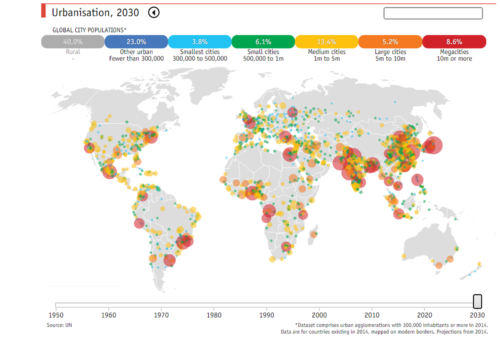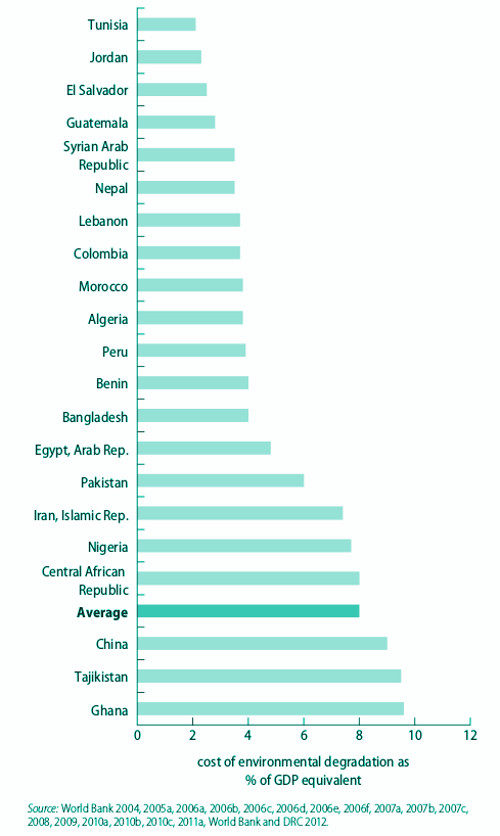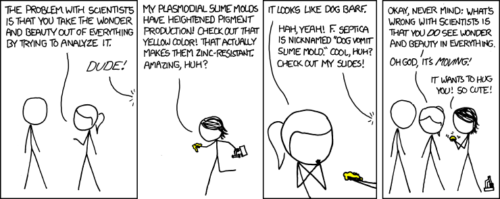Speaking (scientific) truth to power through storytelling: using lessons from the past and examples from the present to plan for the future
Kavya Pradhan, Alterra Sanchez ·Kavya Pradhan and Alterra Sanchez
Like King Arthur’s resolute knights, Environmental Scientists are constantly in their own legendary saga. In our case, instead of the Holy Grail, we are looking for viable strategies for environmental management while taking into consideration the socio-economic and political facets of environmental issues. We strive to find multiple methods that might aid in our pursuit of our own Holy Grail - the balance between environmental protection and economic growth.

In this search, the first place that we often look is narratives of the past in the form of case studies. There is no shortage of examples of the impacts of population growth and economic development on environmental conditions and ecosystem health. Just take as an example the growth of coastal megacites, the resultant impacts on the environment, and the consequent mitigation measures. Moreton Bay (Australia) is an excellent example where, through the development of a research and management program with participation from political leaders, research scientists and the local community, problems of sedimentation and seagrass loss, sewage plumes, and harmful algal blooms were greatly reduced1. Similar case studies are available for many regions in the world with some showing more improvement than others.

A useful tool for the development of management strategies is the driver-pressure-state-impact-response (DPSIR) framework wherein a cause and effect relationship is established between human actions and environmental impacts2. The utility of this framework relies largely on the development of appropriate indicators at each level of the DPSIR framework. Because each coastal megacity is unique, defining common characteristics of indicators of health might lead to a great scientific exercise but may not be very actionable. However, we might be able to identify indicators that matter, while leaving the specifics of the desirable characteristics of these indicators open to regional discernment. As an example, say we chose turbidity and presence or absence of seagrass as a cardinal factor in determining the health of a coastal region. Without the consideration of local environmental information, we might elect lack of turbidity and presence of seagrass as a desirable characteristic (based on our regional bias from the Chesapeake Bay), but these characteristics may be very undesirable for other regions.

In the same manner that we have to be cognizant of the environmental conditions of a coastal megacity, we also have to take into consideration its size, density and socio-economic characteristics while developing management practices. Smaller cities with fewer jurisdictional boundaries may be able to respond much more rapidly to environmental issues than large cities multiple municipal boundaries. The question then arises, “Should management be centralized or decentralized?” Decentralization can lead to a lack of coordination on different front leading to mismanagement of resources, but it could also lead to more local participation and a greater ownership of management actions. The answer may very well be “Both”; a compromise where the locals and smaller level municipalities have greater control of how the resources are managed and how protection is applied while a regional or national centralized body still sets the overall standards. Thus, we can band together and work towards a common goal (if a common goal is possible to find) or participate in mutually beneficial activities (in the absence of a common goal).
The socio-economic characteristics and age of a city are greatly entwined as generally younger cities are booming in more developing nations while older cities are present in developed nations. While mature megacities have gone through a period of rapid development, and environmental degradation, they have had the resources and the time to mitigate the impacts of economic growth. However, the booming megacities in developing nations lack access to methods of sustainable development, and the financial prowess to invest in sustainable development2. Here, global communication can lead to benefits that go both ways. Mature megacites can provide financial, infrastructural, and intellectual reinforcements, while at the same time learning how developing megacities are dealing with their environmental issues. This also allows for an outsider’s perspective, which is essential in not only solving problems, but also realizing that there is one in the first place. Both parties would be learning from the stories of past trials and present accomplishments told by one another.

This brings us to two important points: 1) We do not necessarily need to wait for environmental disasters before we take action to prevent them, and 2) Environmental protection and economic growth are not mutually exclusive3. The trick to accomplishing both of these is planning for the future based on past and present lessons. We also need to correct the portrayal of environmental protection and economic growth as diametric opposites. If we are able to undertake a development approach where the health of the ecosystem is included, we can be proactive rather than reactive. We don’t need necessity to be the mother of invention; instead we need to be inventive with an eye on potential.
We need the input of not only the top scientists, leaders, and inventors, but also the people whose lives and livelihoods are impacted by such management measures. We need to spread the word that environmental problems are human problems and that scientific consensus and research matters. We need to work on making science literacy a part of everyday life by changing our language and understanding that our audience consists of intelligent folks who are simply unfamiliar with scientific vernacular and jargon.
But how do we, as scientists, assist in accomplishing this tall order?
By becoming storytellers (of course).

Stories have a power to capture attention and entertain, while passing on valuable information. And it would not be such a great change from what we currently do. We already tell stories about the past using case studies, about the present through our scientific research and observations, and about the future via projections and predictions. We simply need to make science as fascinating for the masses as it is for us and remind everyone that what we have in the present is a product of our past actions. This might lead us to putting ourselves out there in situations where the political and social waters are contentious, yet this is exactly the situation where speaking truth to power becomes essential.
References:
1. Dennison, W.C., T.J.B. Carruthers, J.E. Thomas, and P.M. Glibert. 2004. A comparison of issues and management approaches in Chesapeake Bay, USA, and Moreton Bay, Australia. In: W.H. Wong (ed), Developments in ecosystems, Vol. 1, Elsevier.
2. Sekovski, I., et al., Megacities in the coastal zone: Using a driver-pressure-state-impact-response framework to address complex environmental problems, Estuarine, Coastal and Shelf Science (2011), doi:10.1016/j.ecss.2011.07.011
3. Feiock, R., & Stream, C. (2001). Environmental Protection versus Economic Development: A False Trade-Off? Public Administration Review, 61(3), 313-321.
Next Post > Talking ecodrought in Portland, Oregon: food trucks, beer and the Benson Hotel
Comments
-
Katie Martin 9 years ago
Storytelling is so important to keep the reasons behind management practices as public knowledge. Additionally, it is crucial for outreach and good science to put research in context of not only past studies but also management actions. Good job, Kavya and Alterra.
-
Hadley McIntosh 9 years ago
Again to echo everyone else, well written blog. I think you have touched on many of the points we keep coming back to in class, i.e. communication and the interwoven connections of science, economic growth, and environmental protection. The discussions and stories we, as scientists but also inhabitants of this planet, tell are going to be crucial over the next few years to have our science heard. I think it is important to remember we do not need to win over the public in every battle, but it is the war or overall health of our planet that we should be striving to win.
-
Ana Sosa 9 years ago
Scientists can be artists, too. I love the idea of making science fascinating and alluring even in the worst f circumstances and emergencies. It is so important that we help every body else in the world achieve a good level of scientific literacy, I think it's our responsibility as scientists.
-
Alterra Sanchez 9 years ago
Awesome blog, Kavya! I think it's interesting that you compared environmental protection policy and economic growth compatability to the ever elusive, and mythical holy grail. It makes me think that things might have to get way worse, and we might have to battle "environmental titans," and probably permanently lose some important systems, before politicians, industry, and the public join the fight.
-
Juliet Nagel 9 years ago
The idea that economic growth and environmental protection need not be mutually exclusive is a very important point, one that is often lost when stakeholders and scientists talk about solving environmental problems.
I also really enjoy the cartoon you included in your blog. It tells a wonderful story of a scientist finding excitement and wonder in their world. By sharing this wonder with those around us through storytelling, hopefully we can effectively speak the truth that the world needs to hear.
-
Stephanie 9 years ago
You mention that story telling should be our way of passing on valuable information, and you succeeded in this way with your post. You provided insight as to how and why things go on beneath the surface but in a smooth and concise way that keeps people reading. It is in this way that you are that successful story teller that is able to deliver a valuable information parcel that helps bring the public and scientists closer to grasping the world around us and how and why we need to manage it together.
-
Qiurui 9 years ago
Good job, Kavya and Alterra. To my knowledge, in UNFCCC Paris Agreement the developed countries have promised to provide fund or technology to help developing countries to adapt to climate change or mitigate the impacts of climate change. (But I heard about some news saying that President Trump is planing to quit from this agreement.)
-
Jake Shaner 9 years ago
Well written blog. Especially like the comparison to King Arthur's knights, though I think my personal "legendary saga" in the sciences often looks more like Monty Python's version... You mention the point that we don't need to wait for disasters to occur before preventative actions are taken, which I agree with. I think storytelling plays a major role in raising support for preventative measures. Is it possible however, that society, at least in more "developed" nations, is becoming desensitized to such disasters, rendering storytelling less effective? The instance of Hurricane Floyd was brought up in class as an example of the public forgetting about prior disasters despite their enormous impacts. Are we possibly getting better at preparing for and preventing environmental disasters, or has the public gotten used to the governmental safety net which constantly repairs and restores environments after all manner of environmental disasters regardless of magnitude?
-
Ginni La Rosa 9 years ago
Very well-written article! When it comes to training both current and future generations of science storytellers, what are the most effective ways they can acquire the necessary communication skills? Are current scientific writing and presentation curricula adequate, or should students in the sciences be encouraged to enroll in more humanities classes? Or are such storytelling skills best learned outside of the classroom?

